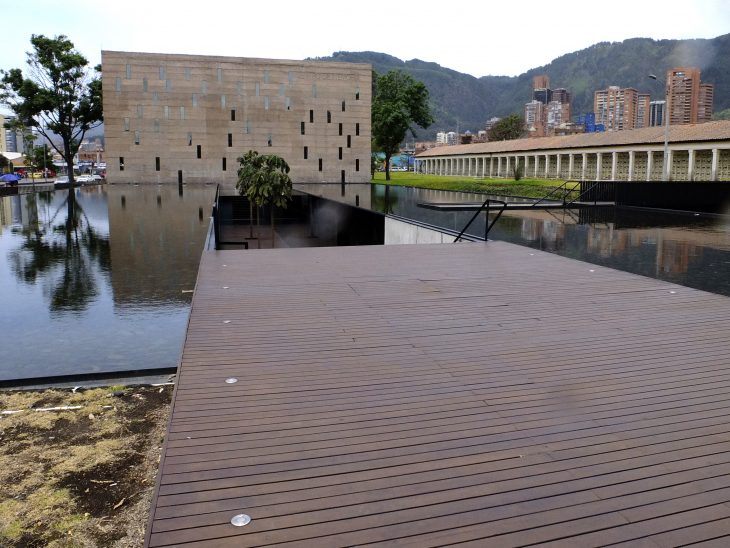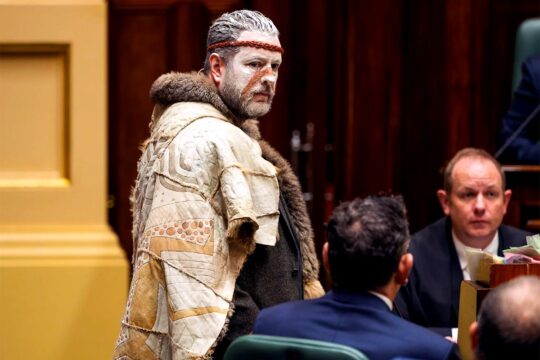Bogota’s Centre for Remembrance, Peace and Reconciliation (CMPR), opened in December 2012, aims to be a meeting space rather than a museum.
The monolithic, earth-coloured building has narrow windows that by night seem to glow like flames and by day are reflected in four mirrors of water. Behind it are the Andes mountains and on one side the main Bogota Cemetery. “Peace is Now” reads a large poster suspended at the entrance to the park where the CMPR’s current directors dreamed for years of being able to build this symbolic place.
The project was initiated in 2008 by the left-wing town hall of Bogota. In 2010, when construction started, the architects found it would take some time since beneath the chosen plot, formerly a graveyard for the poor dating from 1828, they found 3,600 bodies that had to be brought out one by one. “That took two years,” says Roberto Romero, one of the Centre’s founders. “The bodies were not of war victims but they enabled anthropologists to learn about the customs of the time. They were the subject of our first exhibition.”
Romero is a former activist of the Patriotic Union, a leftist movement that was decimated by extreme right-wing death squads in the 1980s. His voice bounces off the sides of an impressive boat placed in the middle of the terrain as he explains that right from the start, this space was conceived as a meeting place. “During the years of excavations and construction, thousands of victims came here,” he says. “There were trade unionists, journalists, Afro-American people, Indians and political leaders.” He then points to test tubes buried in the walls. In each one, visitors have slipped their stories written on a piece of paper and have added a pinch of soil, symbol of one of the main causes of Colombia’s conflict. “These 2,012 memory capsules are just a sample of the 40,000 testimonies conserved in our archives. We also have messages from our illustrious visitors: the Colombian President, the French Prime Minister and even the Prince of Wales!” he says, smiling.
Behind the monumental hall, below the level of the avenue where buses and cars rumble past, are a 400 square-metre documentation centre, a theatre and offices where historians, sociologists and cultural organizers work, plus various temporary exhibition spaces. There are no permanent exhibitions. “We are not a museum that displays objects,” says Romero. “It’s a living, inclusive project that speaks of our social struggles and our dreams.” In a small workshop, a group of men and women who came to Bogota like thousands of others to escape violence are chatting as they stick together diaries to be sold in the town’s bookshops. In them they have written and illustrated their stories. Virgelina Chara, who heads an association of displaced former prostitutes, shows some large pieces of woven cloth. “They represent what we went through and some of the events in this country,” she explains. “It’s our way of protesting.”
Along with some 20 others Virgelina, who arrived 12 years ago from southwest Colombia, hosts visits by schoolchildren. “With singing and theatre, by cooking our traditional dishes that you don’t find in the city, we are able to tell what happened,” she says. “Many of them don’t know anything about it.”
To make sure people do not forget, the Remembrance Centre, which has had 200,000 visitors since 2012, organizes meetings and conferences, including outside the Centre. It has drawn up a map of the places of remembrance in Bogota. The places where presidential candidate Jorge Eliecer Gaitan was killed in 1948, where left-wing activists, journalists and artists were shot dead are all marked with a plaque telling their story. Demonstrations and rallies are held there. Along the avenue on which the Centre was built, frescos and graffiti art illustrate 50 years of the Colombian conflict.
The authorities are planning to turn this road, through which visitors arriving in Bogota by plane inevitably pass, into a “path of remembrance”. It would include the CMPR, the Cemetery and a National Museum of Remembrance that is to be built in the vicinity. Soldiers who died in combat have already had their own memorial for a long time, symbol of a common history that is still long and hard in the making.






